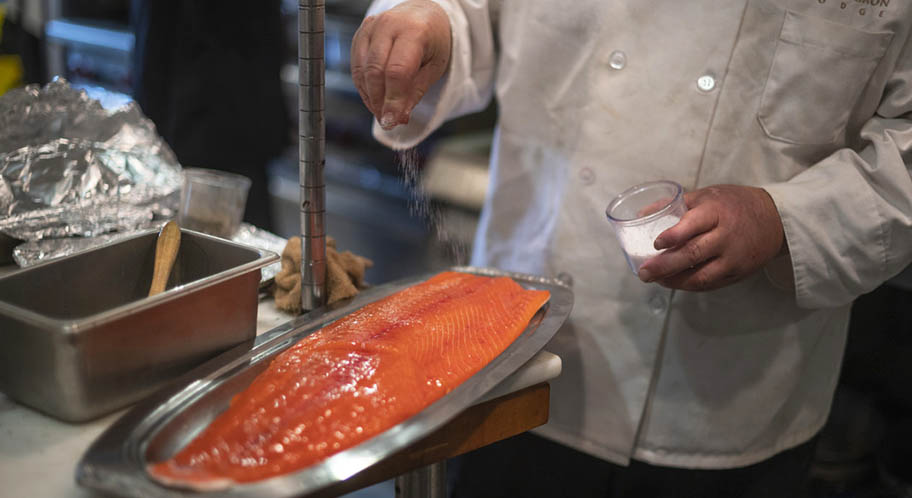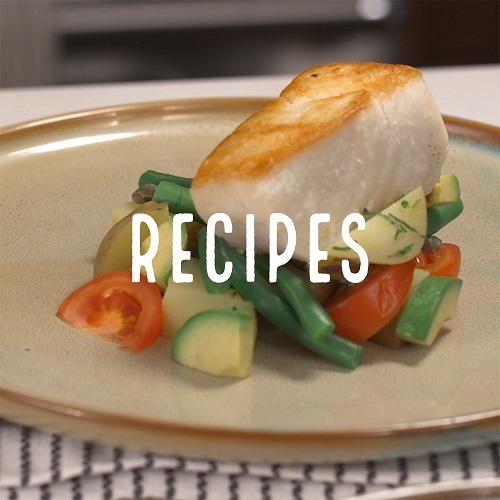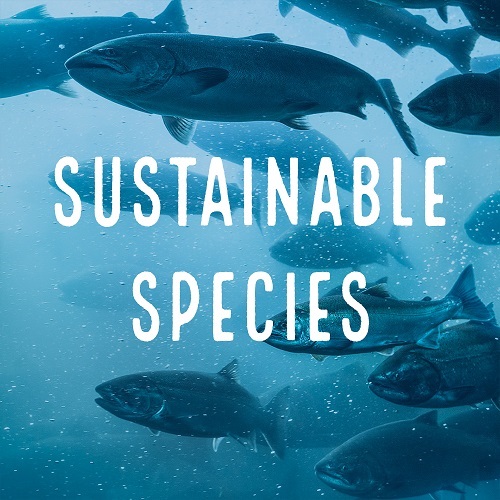There’s a saying in the seafood industry: the West eats cod, the East eats mackerel and everyone eats salmon. It’s not surprising that this pretty pink, suppertime all-rounder frequently polls as the world’s most popular fish. What other fish has the vibrant copper color of wild Alaskan sockeye, covers 50 shades of trendy coral pink through all its varieties and can be salt cured and oak smoked to produce the taste sensation that is smoked salmon?
So whether you’re eating chinook or keta, sockeye or coho, here’s a guide to salmon, exploring its different tastes and textures, recipe ideas and cooking tips and sustainable outlook. Because for some of us, life without salmon is unthinkable.
I’ll cover the two main types of salmon – wild-caught Pacific and its different varieties, and then farmed Atlantic. For each variety there are sustainable and non-sustainable salmon available. We always consider sustainably sourced salmon to be the better choice, no matter how delicious, or indeed how cheap, a non-sustainable piece of salmon might be. Careful choices by consumers protect salmon which in turn protects its habitat and everything in it.

Wild Pacific salmon
Where it's from: These salmon species use the entire Pacific Rim coastline, ranging from South Korea to Southern California and northwards to Russia and Alaska. Pacific salmon are currently expanding along coastal areas of the Arctic Ocean.
Every year in late spring, the wild salmon season leaps into action in the North Pacific Ocean. Migration routes are very long and vary in length by species. Hundreds of millions of salmon begin their homeward journey from the icy oceans to the vast network of inland rivers and streams. In the Pacific Northwest, the majority of fresh wild salmon is harvested in June and July – more than 200 million salmon annually – though the season runs through the end of September. However, wild salmon is available year round in convenient forms such as frozen, pouched and canned, the latter being a traditional way of preserving the seasonal surplus.
No question, wild is a superior salmon. Chefs love its natural variability. It’s tastier, has a firmer texture and is higher in protein than farmed salmon. Its deeper color, which it gets from the same shrimp-rich diet that turns flamingos pink, even looks more appealing. Later in the season, wild salmon switch to a diet of anchovies and sardines so the meat is a lighter pink and the taste more pronounced. As such its most highly prized seasonal varieties can be significantly more expensive than farmed salmon.
There are five species of wild Pacific salmon in the North Pacific waters: chinook (king), sockeye (red), coho (silver), pink (humpback) and keta (chum/dog/silverbrite) which give consumers a generous range of price points. Each has its own flavor profile and suits different preparations and recipes. Masu and amago species of salmon occur only in Pacific Asia.
There are a variety of Pacific salmon products carrying the MSC label in stores and restaurants worldwide, from prepared meals to fresh and frozen salmon. According to the Wild Salmon Center (WSC), a leading group working to protect and conserve wild salmon strongholds around the entire North Pacific, Alaska ranks as one of the world’s healthiest and best managed fisheries whose limited harvests don’t endanger the long-term health of fish stocks. A very high percentage of Alaska salmon fisheries are MSC certified, as are a number of Russian fisheries.
Although some salmon populations on the West Coast are mentioned as endangered below, sustainable MSC fisheries do exist in this area and products are available with the blue fish label that guarantees the fish is indeed sustainably caught and not on the Endangered Species Act (ESA) list.
Did you know?
Salmon are anadromous fish, which means they are born in fresh water, migrate to the ocean where they spend most of their adult life, then return to fresh water to reproduce.

Chinook (King)
Not named after a military helicopter but after the Native American tribe that used to inhabit the shores of Washington and Oregon’s Columbia River and for whom salmon was a staple food. These heavyweights of the salmon clan can weigh up to 100 pounds (45kg), though typically king salmon land at around 25 pounds (11kg). The least abundant of the five North American species, chefs love its bright silky flesh, buttery texture and mildly sweet flavor.It’s worth splurging out on an early season chinook. It has the firm flesh of a fish that has freely explored its natural habitat and a ruddy color from a diet of shrimp and krill (a small shrimplike crustacean). Chinook salmon from Copper River in south-central Alaska are among the first to hit the shelves of stores each year in mid-May and are available fresh for about a month.
This versatile salmon is high in oil so it can be griddled, poached or even smoked without the risk of drying out too easily. Try it grilled over charcoal – charred chinook belly and fat-streaked collar are foodie favorites at upmarket restaurants.
If you are going to splash out on chinook then make sure it’s from a sustainable source. There are distinct populations from Alaska to California, and some are in better shape, biologically, than others. For example, some populations in California, Oregon, and Washington are listed as threatened or endangered under the Endangered Species Act (ESA). The reasons for decline are many, but range from humans paving over watersheds, development and water pollution coupled with the ruinous effects of climate change.
In recent years, some chefs in Seattle have taken chinook off their menus because they believe the fish is integral to the summer diet of the struggling orcas (killer whales) in the US Pacific Northwest and British Columbia. However, fishing and environmental organizations were concerned that this would lead to confusion with American consumers believing that all chinook salmon is ‘bad’ and in low supply. This is not the case, as there are plenty of well-managed chinook populations in the Pacific Northwest and Alaska.
Sockeye (Red)
Sporting a distinctive reddish copper sheen and dense meaty flesh, sockeye is instantly recognizable. Its deep color is a result of the high number of krill in its natural habitat, near the Bering Sea. Leaner and lower in fat than Chinook, but more assertive in flavor, sockeye is commonly sold smoked, in gourmet fish burgers, and by the fillet. Its roe is used as salmon caviar for sushi. Find it fresh from mid-May through mid-September.Try cooking sockeye fillets on a hot, well-oiled grill or seared in a pan, brushed with lemon juice, starting with the skin side down first; don’t overcook and avoid masking its natural flavor with hefty sauces. Alternatively, sockeye is a star ingredient in Hawiian poke bowls, and makes amazing homemade gravadlax using sea salt flakes, crushed pink peppercorns and aniseed wisps of dill.
There are hundreds of sockeye salmon stocks in Alaska and several Pacific stocks. Some stocks are in decline, while others are steady or increasing. As of 2018, one population of sockeye salmon is listed as endangered and one is listed as threatened on the West Coast under the ESA. Sockeye salmon can migrate all the way to inland lakes in Idaho, and others return in mass numbers to Bristol Bay Alaska, site of the largest sockeye run in the world.
Meet Emily, a fifth-generation salmon fisher in Bristol Bay, Alaska
Coho (Silver)
Up and coming Coho has a mild but distinctive flavor. This lean and mean fish is a bit of a fighter according to fishermen. It has a medium fat content (less than sockeyes and chinook, but more than pinks and keta) and is the most widely available autumn-fresh salmon.Coho is best treated with care. Try poaching fillets in a citrus broth, steaming en papillote with ginger, soy and spring onions (scallions) or, because it’s not a huge fish like the chinook, slash and stuff the skin of a whole salmon with aromatic garden herbs and lemon zest and serve it as a table showpiece roasted in the oven or on the grill.
Alaskan populations of coho salmon are generally healthy. The status of coho populations in California and the Pacific Northwest varies, but at least some stocks in all areas of the Pacific Coast are classified as endangered or threatened under the ESA.
Pink (Humpback)
The fairest member of the salmon family, pink salmon is lightly colored, low in fat and mildly flavored. It is fished in huge quantities in America and the vast majority ends up processed into a can or pouch. Canned salmon works well with various dairy and carb combos such as salmon and broad bean pasta bake, salmon dauphinois, and quick salmon kedgeree with lime and coriander.
Commercially fished from Washington up to Alaska, pink salmon is the most abundant Pacific salmon and a smart seafood choice because it is sustainably managed and generally not overfished.
Keta (Chum/Dog)
Prosaically named chum salmon is a smaller species fished in vast quantities. It has a rosy pink flesh and is lower in fat than other varieties. Chum is mostly canned, eaten as fillets or makes delicious roe.In fact, its roe is well respected by sushi chefs, because of its size and flavor. Its eggs produce the plump, amber pearls that fill ikura sushi rolls. Chum is popular dried or dehydrated and ground into flavor-rich rubs. It’s also smoked and stands up well in creamy chowders and coconut-based curries. High in protein and low in fat, it has become a popular choice with healthy eaters.
There are hundreds of stocks of chum salmon in Alaska, and generally it is a sound seafood choice. However, a small number of chum salmon populations on the West Coast are protected under the ESA.
Did you know?
In 2018, The Food and Agriculture Organization of the United Nations (FAO) estimated global consumption of 123 million tonnes Ready to Cook Equivalent of poultry versus just 3.2 million tonnes of farmed and wild salmon.
Farmed Atlantic salmon
Where it's from: Most commercially available Atlantic salmon is farmed, providing about 72 per cent of the world’s total salmon harvest. Atlantic salmon is farmed across the globe but by far the two largest producers are Norway and Chile, whose coastlines provide optimum conditions for production. Farming takes place predominantly in open-net pens in sheltered waters such as fjords or bays. Scotland, Canada, the Faroe Islands, Tasmania, Ireland and Iceland also farm Atlantic salmon. The US is the world’s biggest importer of Atlantic salmon, Germany, France and the UK are traditionally major markets, while China is the fastest-growing market. In China, fresh Atlantic salmon fillets are often served sashimi-style in Japanese sushi restaurants, but frozen, fresh or smoked salmon is increasingly found in modern retail outlets and through e-commerce channels. In Japan, Atlantic salmon is popular in a range of sushi dishes such as nigri and hosomaki. Most of the fish are imported, chiefly from Norway and Chile, though recently there are initiatives to farm Atlantic salmon in Japan and China.
Available fresh all year round, Atlantic salmon’s mild flavor, fleshy texture and pocket-friendly price makes it a popular choice worldwide. In many important markets, Atlantic farmed salmon is listed in the top five species being consumed. While discerning pescaphiles might sing the praises of the flavor and provenance of wild-caught salmon, others say farmed makes better smoked salmon because of its higher fat content. Its versatility means it can be cooked most ways, from poached to pan-fried, and even cured, cold-smoked and hot-smoked.
The natural color of salmon is dusty grey. Wild-caught salmon picks up its pink coloring naturally from the food chain, while farmed salmon gains its color from the pigments in its feed. The color of the fish can vary widely from russett to light pink according to the amount of pigment in the diet.
The Aquaculture Stewardship Council (ASC) is an independent non-profit organization that sets a voluntary standard for responsibly farmed salmon. The certification process is carried out by third-party auditors and if certified, the ASC logo can be used on pack as a trusted indication that the seafood came from a truly responsible farmer who seeks to minimize environmental and social impacts. These include reducing pollution from pesticides and waste in the surrounding seas, limiting reliance on chemicals and medication, and improving working conditions.
Did you know?
Farmed salmon produces a fraction of the carbon generated by the beef industry. The carbon footprint for farmed salmon is 2.9 carbon equivalents per kilogram of edible product compared to as much as 30 for cattle.
Nick Wyke is a journalist and food writer who is passionate about local, seasonal and sustainable produce.
Sustainable salmon recipes

Recipes
Find a new favorite dish in our collection of sustainable seafood recipes from expert chefs.

Cooking Tips
For cooks of all levels, check out these tips and tricks for the best sustainable seafood dishes.

Sustainable Species
Find out if your favorite seafood options (and more) are good for you and the ocean too.
